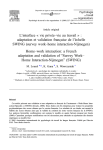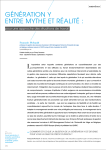Download Examining Managers` Careers at the Crossing of Gender and
Transcript
"Examining Managers' Careers at the Crossing of Gender and Age" Abstract This paper reviews the literature with a view to grounding empirical comparative research on male and female managers' careers with regard to three age categories: managers aged up to 35, between 35 and 50 and above 50. It considers both men and women as professional careers are influenced by gender as well as by stereotyped gender roles. Hence, distinguishing these age categories affords consideration of evolving contextual factors such as genderspecific roles upheld throughout time. Indeed social perceptions with regard to gender can vary from one generation to another and sensibly affect career choices. Thus considering age in correlation with gender leads up to broaching "intersectionality", a concept which in diversity management consists in crossing the target groups concerned. This theoretical overview of the literature relating to the careers of managers yields a theoretical frame of reference along with qualitative propositions to be tested subsequently in the field. Keywords: Career, professional path, gender, generations, intersectionality 1 "Examining Managers' Careers at the Crossing of Gender and Age" 1. Introduction This paper proposes to review the literature relating to the careers of male and female managers with regard to the generation they belong to. While considerable scholarship has been done on career management, on women's careers and the "glass ceiling" phenomenon, and on career perception by various generations, very little of this scholarship has integrated a comparative approach combining gender and generations. Conciling both angles when examining managers' careers falls within the scope of diversity management and, more particularly, that of studies bearing on "intersectionality" (Cornet, 2010; Tremblay, 2005), i.e. individuals' differentiated position with regard to their belonging to several dimensions of diversity. This enquiry, essentially, means to investigate whether crossing both dimensions yields a better understanding of male and female managers' views and behaviours. Several studies reveal persisting differences between men's and women's careers (Belghiti-Mahut & Landrieux-Kartochian 2008; Laufer, 2008) though also that professional equality has greatly evolved over the 30 last years. Men and women from various age groups and generations thus might also manage their career differently in a context of evolving social and gender roles. The first part of this literature review focuses on clarifying career as a notion; i.e. identifying the various career types and their possible relation to gender or generations. The second part surveys studies dealing with the correlation of gender/sex category to career, which will enlighten the divergences between those dealing with gender and sex. The third part looks at the careers of managers in terms of age and/or generations. Subsequently, on the basis of this state of the art we draw our analytical model reflecting the gender/generations intersectionality of managers' careers while presenting a set of qualitative propositions drawn from the most structuring elements of the argumentation. A fourth section, the discussion, proposes to examine how, from an empirical viewpoint, these three categories of studies can be combined to yield research questions awaiting validation. 2. Careers 2.1. Career as a Notion Career designates an individual's path throughout their professional life. This path can be looked upon objectively or subjectively. The first approach consists in observing facts, behaviours and positioning indicators such as salary, duties, hierarchical rank, etc. The second approach, on the other hand, looks at the individuals' perception of their career (expectations, strategies, satisfaction level, etc.) and the factors which have influenced it (Roger, 1992). Several authors propose a chronological account of career. Thus, Miller and Form (1951) define career as "the succession of diverse stages unfolding over time, according to the individuals' age and characterized by settling, progressing, stabilizing and retiring". This chronological account is often linked to age but also to years of experience. At individual level, one speaks of "career anchor", a notion which refers to the behaviours, attitudes standards and values of individuals put forth when accounting for their professional path (Schein, 1978; Cerdin, 1996, 1999). Schein (1978, 1990) identified several career anchors: technique, management, autonomy, stability, creativity, lifestyle, challenge and service. Career often results from a certain number of compromises made between working and private life. 2 Career derives from individual choices and strategies though also from organizational practices generally integrated into Human Resources Management policies. These policies underlie horizontal mobility opportunities (changing job, sector or duties) and vertical ones (climbing up). Career management mode depends on organizational culture yet also working and/or national or regional cultures. The literature also distinguishes between classic and "boundaryless" careers. The first refer to a long-term relation between the company and the individual. Classic careers consist in a process in which each stage corresponds to a threshold in terms of pay but also, for some people, managers namely, rank progression. The relation between the company and the individual is based on dependence. This type of career can only be considered in a fairly large and organized promotion and relies on actors such as Human Resources appointed to the task of guiding career evolution and setting the rules or management policies enhancing individual progression. "Boundaryless" careers are mobility models involving voluntary company changes. Such careers are linked to work mobility along with the individuals' willingness to live different experiences and to build up skills and expertise (Dany et Livian, 1995; Falcoz, 2001). In this particular situation, mobility and learning depend more on the individual than on the firm. Careers are no longer confined within the company walls but consist rather in a set of employment opportunities extending beyond one and the same workplace (Cadin, 1997). 2.2. Career Success Career success can be measured according to multiple -either objective or subjectivecriteria and indicators. It can be judged by salary progression but also by hierarchical rank progression in the company (Miller et Form, 1951); Hall (1976) as well mentions hierarchical or financial performance. Van Maanen and Schein (1977) and Hall (1976) have it about internal satisfaction: satisfaction level, the individual's own career perception and evaluation. Hall (1996) calls "psychological success" the feeling of personal pride and self-realization arising from fulfilling essential individual goals, whether these concern professional accomplishment, family happiness, inner peace or whatever else (Hall, 1996). Bastid (2004) identifies various factors likely to influence the feeling of career success, namely the richness and diversity of professional experiences, formal and informal closeness with senior management, involvement in strategic decisions, influence and the ability to reconcile private and professional life. 2.3. Career Ceiling Various authors such as Evans and Gilbert (1984) and Veiga (1981) define the career ceiling as the time period characterized by poor chances of moving up the hierarchical ladder along with career stagnation. Here also there is an objective and a subjective dimension in which individuals perceive their career ceiling and the feeling of being freeze in their professional evolution (Ference et al. 1977; Chao, 1990). This brief overview of the literature relating to careers highlights various theoretical elements yielding guidelines for research: - Objective career elements (salary, positions and duties, hierarchical rank, etc.), - Identifying stages and changes as well as reasons given to account for these changes (individual choices, organizational constraints, other contextual factors, etc.), - Subjective career perception (satisfaction level, etc.), - Career profile (classic or "boundaryless"). 3 3. Careers and Gender Numerous studies have shown differences between men's and women's careers and throughout all professional categories. A better understanding of these differences calls for taking up sex category as an independent variable but also gender, i.e. the social construction of male and female roles in a given society. Indeed, around men's and women's physical differentiation, there appear representations of men's and women's properties (stereotypes, gender-specific perception of competences, gender-specific behaviours, etc.), roles and behaviours considered "natural" for each sex and articulating separation between and differential valuation of men versus women. Male and female social dynamics shape men's and women's personal and professional path. 3.1. Gender-based Careers From the early sixties on there has been a growing number of female managers linked with women's rising education level. As a result of growing coeducational schooling opportunity and women's desire to occupy responsible positions, careers nowadays are more mixed than before. The introduction of more formalized HRM models (Pichault & Nizet, 2000) has also allowed women to climb up the hierarchical ladder. This does not mean for as much that men's and women's careers are becoming thoroughly undifferentiated. Indeed, despite their fair school performance and growing presence in higher education, manager women still do not manage to get professional path similar to men's (Belghiti-Mahut & LandrieuxKartochian, 2008; Cornet, Laufer, & Belghiti, 2008; Laufer, 2007; Laufer & Fouquet, 1997). Educational background is not enough, several other factors come into play such as the force of stereotypes and of so-called "male" organizational standards, indirect and systemic discriminations inherent to HRM structures and policies, gender-based roles and the malefemale distribution of family and parental tasks (Bastid, 2004; Charbeau, 2009; Laufer & Fouquet, 1997; Moss-Kanter, 1977). Most studies concerning managers have been conducted around male models (MossKanter, 1977), as women used to be very little represented within this socio-professional category. Managers thus are perceived as individuals who put work before private life and who can rely on partners managing family and children. This comes very clearly out of studies relating to expatriate managers which, until lately, essentially concern male managers and their spouses. 3.2. Female Managers' Career Some research show that female managers' career typically features horizontal segregation (male or female overrepresentation in certain occupations and positions) and vertical segregation, also called the "glass ceiling". Thus female managers are especially found in certain occupations and positions (Human Resources, communication, etc.), which are perceived as fitting so-called "female" competences (interpersonal skills, etc.) (Maruani, 2011). These positions are often less valued in the organization, as compared with positions relating to operational, technical and financial responsibilities, which are still mostly occupied by men (Gavray, 2004; Laufer & Fouquet, 1997; Testenoire, 2001). These posts are also less promising in terms of career and promotion, they also stand out as being less remunerated as compared with other more male-oriented positions (Lemiere & Silvera, 2008). Studies addressing the glass ceiling aim at accounting for women's under-representation at the top and in management positions. Numerous studies, therefore, aim at gathering information on the difficulties women run up against in managing their career (Belghiti-Mahut & LandrieuxKartochian, 2008; De Bry, 2005; Gresy & Dole, 2011; Guyon, 196; Laufer, 2008; Maruani, 2006). 4 Differences between male and female managers' careers are accounted for by direct and indirect discriminations linked to Human Resources Management policies and to the organization of work (Gresy & Dole, 2011; Laufr, 1982; Moss-Kanter, 1977) though also by the effect of women's individual strategies (Bastid, 2003). These strategies and behaviours would be derived either from women's positioning within their social group (Ferrari, 2011), or from individual choices linked to biological, psychological and psychoanalytical differences between women and men (self-assertion, career-minded behaviours, attitude towards power, etc.) (Burke & Sada, 2007; Lunghi, 2005). Several studies also reveal the force of the genderbased role distribution within households upon women's career (Gardner, Meda & Senik, 2005; Messing, Vogel, Gronkvist & Lagerlof, 1999; Normand & Tremblay, 2005). Even though there has been an evolution in the allocation of tasks over these last years, family and parental duties nonetheless remain a mostly female constraint (Meda, 2001). Men's professional career seems to be positively affected by the number of children whereas the contrary is true for women's (Belghiti-Mahut & Landrieux-Kartochian, 2008). Laufer and Pochic (2004) thus argue that while men's career largely relies on their spouse/partner's availability, women managers are rarely in same situation. They far more often find themselves in a "double-career" partnership (Laufer & Pochic, 2004). Fagenson (1990) highlights the relevance of the organizational, societal or institutional context as a response, albeit at a varying pace, to environmental changes (Fagenson, 1990, Parker and Fagenson, 1994). So, Gavray points out that women's lacking ambitions can be owing to their relatively recent access to self-sufficiency (2008). Bender and al. (2001) underline an increase of certain difficulties relating to women in the specific context of so-called "boundaryless" careers, namely in the NTIC sectors (Bender, Pigeyre & De Saint-Giniez, 2001). Nevertheless, self-limitation, the prominence of work upon private life and part-time work are likely to hamper women's inter-organizational mobility. 3.3. Career Success according to Gender Some studies also choose to investigate the subjective view of career along with men's and women's account for their career success. So, it comes out that men would tend to attribute their career success to their abilities and skills whereas women would seem to put it down to luck and to their efforts (Culter & Jackson, 2002). Women's career success models quite often differ from men's. Women would be as much satisfied with their career as men while working at a lower hierarchical level or receiving a lower salary (Dann, 1995). Women managers would define their success in terms of selffulfillment, self-realization and personal recognition whereas men have it about pay and hierarchical rank (Bastid, 2004). This review of the literature relating to gender and careers allows us to add several elements to our observation checklist: - Men's and women's position with regard to occupations and positions (horizontal segregation), - Men's and women's position with regard to hierarchical rank levels (vertical segregation), - Objective elements possibly accounting for differences in positioning (career break, parttime work, etc.), - Subjective perceptions of the factors influencing career and perception of the impact of sex category and gender (stereotypes, social roles, etc.), - Gender-based perception of career success. 5 4. Careers and Generations Career perception is likely to vary according to the individual's age and lifecycle. We propose to consider three distinct age categories: those under 35, those aged between 35 and 50, and those aged above 50; we propose to consider these groups in terms of three distinct generations: the "Y" Generation, the "X" Generation, and the "Baby-Boomers". This division is partly arbitrary and the association with the three above-mentioned generations is far from being that simple; it seems to us, though, that this can be taken as a relevant startingpoint likely, of course, to be questioned in the light of the empirical data. As far as age is concerned, these three age categories correspond to three target groups which are increasingly identified in age management policies, namely the period of socioprofessional integration, associated with young people; the mid-career period or mediors; and the seniors or elderly workers. 4.1. Generations as a Concept In terms of generations, three groups are concerned: the "Y" Generation (after 1978), the "X" Generation (between 1962 and 1978), the "Baby-Boomers" (born between 1945 or 1947 and 1962). The generations refer to an age group whose limits are far from unanimously defined; age categories vary among authors by about 5 years (Twenge, Campbell, Hoffmann, & Lance, 2010). The generations include individuals who were born over the same period and share social and historical events. A generation is a cohort characterized by common cultural, economic, social, technological and historical transformations (Méda & Vendramin, 2010). The idea is that these events are bound to create common value systems distinguishing these individuals from those living at another time. The three generations thus would give attach different value to work, private life, leisure, family life, social life, political commitment, gender equality, etc. (Godard, 1992; Guerin & Fournier, 2004; Twenge, 2010; Twenge et al., 2010). Studies seem to show that, for each of the three generations, work remains a determining aspect of life in grounding social and personal fulfillment (Méda & Vendramin, 2010; Pichault & Pleyers, 2010). On the other hand, the degree of personal commitment to work appears to vary according to generation and age (Twenge et al., 2010). The differences observed between generations can also be attributed to career stages (twenge, 2010), lifecycles (Lyons, Duxbury & Higgins, 2005) or age (Wong and al., 2008). In some instances, also, there is greater variance within a generation than between them (Macky, Gardner and Forsyth, 2008). According to Giancola (2006), the generation conflict is more fictive than real. Various analyses also show that members belonging to the same generation variously experience the events coming their way. Race, gender and social class indeed are also likely to shape their experience. Finally, Giancola (2006) emphasizes that, in many cases, few differences are observed between generations and that these are insignificant as compared to resemblances. 4.2. The "Baby-Boomers" The "Baby-Boomers", in Europe at least, generally grew up in fairly traditional societal models with the man functioning in the role of breadwinner and the woman as housewife, with exception made for the poorer classes where women were bound to work for money. Women's work, at the time, was perceived as a necessity, not an individual choice (Coenen, 1998). Yet, this is also the May 68 generation. Whether as teenagers or young adults, they have experienced a society going through deep transformation and social revolt questioning the consumer society, the rejection of authority, the crave for happiness, the sexual revolution, 6 the wish to give meaning to their life along with a good measure of utopia and political commitment. As concerns gender equality, this is also the time of strong feminist movements which i.e. demand education for girls and financial independence through work for women. This is also the generation who gets into the job market at a favourable time, namely for the best qualified among them, who massively get the management and executive jobs which are then in the process of becoming professional and specialized in companies (Boltanksi, 1982). This generation of workers is presented as structured, logical and organized. On the managers' side, career success is perceived as being important. Their career can be linked to their formal degree though their access to such posts can also follow from their experience and past duties in the company. They are seen as being loyal and highly committed to their firm. This is model separating private and professional life with little concern about reconcile family life, at least on the side of men, who largely rely on a sexual division of housework and parenting. Here also, when they have children, women opt out of -wholly or partially- of the labour market to take up family and parental care (Guerin & Fournier, 2004; Lyons, Duxbury & Higgins, 2005; Marbot, 2005; Peretti & Marbot, 2006; Twenge et al., 2010; Yang & guy, 2006). This generation is the first concerned by all restructuring waves of the past 20 years, put under strong pressure to step down before their time from a labour market which relies on early retirement while advocating the right to enjoy retirement and the need to leave jobs to a younger generation facing a rocketing unemployment. 4.3. The "X" Generation The "X" Generation is perceived as a transitional generation (Marbot, 2005; Méda, 2001; Twenge et al., 2010; Yang & Guy, 2006). They are now mid-career professionals. Their education level is generally higher than the previous generation. Their parents were influenced by the May 68 values of autonomy, freedom and independence. They want to be involved in decision-making. They come out as being more individualistic than the previous generation and with lesser political and social involvement. They have taken advantage of the growing consumer society along with ever more leisure opportunity. While family remains important (Gavray, 2008), there is a rising number of women working, and in France and Belgium alike, fewer and fewer of them stop work on bearing their first child (Maruani, 2006). Those who leave the job market, rather are mothers of two if not three children. Women also increasingly demand a redistribution of family and parental roles and expect fathers to take up a greater share of housework and parenting. Changes, however, are a long time coming as appears from most studies of task-sharing and life-work balance models (Méda, 2001; Tramblay, 2005). This is an age-group which has also experienced a sharp evolution in family models with an explosive number of single-parent families and a steady increase of reconstituted ones. As well, this generation feels ever more threatened by the transformation of the economic world (internationalization, mergers, externalization, etc.). Even though they may have stayed within the same company, this has gone through a good deal of restructuring (Demers, 1999), along with changes in company status (e.g. privatization of public services), take-overs, mergers, shifts in top management teams. Many have changed companies, more out of necessity than choice. Confidence in companies is dwindling and an ever smaller number has hopes of staying on the payroll until retirement. They are also put under increasing pressure to work past the age of retirement. Whereas earlier generations saw themselves entitled by right to take early retirement, these workers entertain little hope of doing so. They find themselves in ever stiffer competition with a younger generation equipped with better and higher qualifications considered ever more as the most legitimate access to an management position. 7 4.4. The "Y" Generation There exists an abundant literature devoted to the "Y" Generation. Our aim here is not to cover it all but to extract this generation's essential values, norms and behaviours. Young managers have a high academic level (Méda & Vendramin, 2010). Like the previous generation, they are portrayed as keen on independence and autonomy. Immediacy is often cited as their foremost characteristic. They are said "to want everything at once", to be egocentric and to have a high idea of themselves. They pass off as having an open mind and especially aware of -i.a. cultural- differences. Yet, they would be less confident than the previous generations, though, about their future, a feature which is presented as related to their parents' employment experience. This would account for their having short rather than long-term projects. They would hope flexibility, challenges, recognition and self-realization. Work remains an important value owing to the financial independence that comes with it though they hope to combine enjoyment and work, or to put it differently, to have a job they like and which they enjoy not only for its content but context as well (Cornet, Delhaye, & Maréchal, 2009). They would also be versatile as a result of their ability to handle the various technological tools. Some complain about a lack of respect for hierarchy related to their subordinates' strong demand for self-reliance and expectation of work flexibility to accommodate individual needs. They would value teamwork and -i.a. virtual- networking, even though results on this front may be contradictory (Wong, Gardiner, Lang, & Coulon, 2008). For having no loyalty to their employer and no sense of belonging to their company, theirs would tend rather towards the "boundaryless" career. Regardless of their sex category, they would also demand a fair balance between life (i.e. leisure, friends, family, etc.) and work (De Bovis, Glee, & Fatien, 2009; Delay, 2008; Olivier & Tanguy, 2008: Twenge et al., 2010). Men would take up a larger share of family life, especially of parenting, with housework chores being left to the charge of external hands (Tremblay, 2005; Vendramin 2007). This theoretical review of careers in relation to generations highlights some additional elements with relevance to our research: - The distribution of individuals within three age categories: under 35, between 35 and 50 and above 50 with regard to occupations, duties and hierarchical levels, - Subjective perceptions of the factors influencing career and career success, and perception of the impact of age (norms, behaviours, etc.), - Subjective perceptions of the various generations' values (according to the importance given to work, private life, leisure, social life, political involvement, gender equality, etc.). Drawing on this review of the literature pertaining to career issues -careers with regard to gender and generations- we propose a theoretical frame of reference highlighting the intersectionality in terms of gender and generations of managers' professional path, as well as a set of qualitative propositions; these provide a basis for our empirical research as we mean to test these against the reality of the field. These multiple propositions, we think, reflect the most structural elements of this literature though also the data we have chosen to analyse as to the possible underlying generational and gender differences. This frame approaches four issues, i.e. success, the stages and career changes, work-life balance, and finally, career as such. Of these, work-life balance is the only term not to have been defined in this state of the art. Thus the concept concerns a kind of inter-role conflict wherein the demands of work and family roles can be mutually incompatible (Greenhaus & Beutell, 1985). Indeed, filling one of these roles can hinder or complicate filling the other. There is conflict when individuals feel 8 that the expectations, needs and duties of their family role run counter to those of their professional role and inversely (Frone & Rice, 1987). 9 Theoretical frame of reference (qualitative propositions) P1 : Success P2 : Stages/ Changes P3 : Work-life Balance P4 : Career Men Y Generation P1.1 : Feeling of work enjoyment Women P1.2 : Self-‐realization at work and enhancing their degree Men Y Generation P2.1 : Voluntary changes induced by better opportunities Women P2.2 : Getting on professionally before starting a family Men Y Generation P3.1 : Voluntary and greater involvement in parenting and significance of private life (friends, leisure, etc.) Women P3.2 : External help to enhance this balance and demand for the partner's greater involvement, claiming the right to respect for private life Men Y Generation P4.1 : Boundaryless Women P4.2 : Classic by choice X Generation P1.3 : High salary securing a comfortable standard of living P1.4 : Achieving economic independence from their partner through work Baby-Boomers P1.5 : Linear career progression through vertical mobility P1.6 : Emancipation through work X Generation P2.3 : Internal or external changes by force of circumstances linked to social contract termination P2.4 : Temporary or partial withdrawals from the labour market for family reasons are negotiated within the couple Baby-Boomers P2.5 : Internal changes within the social contract with the company X Generation P3.3 : Forced involvement in housework and parenting tasks is linked to the "double career" couple P3.4 : Considered superwomen trying to reconcile work and private life (difficulty) Baby-Boomers P3.5 : Career gets priority, possibly induced by traditional family model (spouse's availability) X Generation P4.3 Classic by choice and boundaryless by necessity P4.4 : Willing to adjust to the male career model Baby-Boomers P4.5 : Classic P2.6 : Disadvantaged by their withdrawals from the labour market at childbearing age (= the norm) + glass ceiling P3.6 : Housework chores and parenting duties come before career P4.6 : Often interrupted 10 5. Discussion Amongst other things, our research aims to verify how relevant such a categorization by age and generations is to understand the positioning of male and female managers on the labour market; or whether we need to include other frames of reference, such as the concept of lifecycles (Lyons et al., 2005; Tremblay, 2005) and career stages in correlation with i.a. evolving personal and family models (Bawin-Legros & Stassen, 1996; Chrisman, Sharma, & Taggar, 2007). To several researchers, though, this generational categorization makes no sense (Giancola, 2006), this would merely be a social construct relying on social and political issues and reflecting the biased nature of the samples used in this research (Pichault & Pleyers, 2010). It will also be our task to examine how this issue of gender and age combines with other aspects of diversity, origin, for one (Cornet, 2010). Notwithstanding its suspected limits, we feel that the comparative analysis of the perception of career by male and female managers through various generations could yield fresh insights into the Human Resources Management policies to implement in order to enhance the involvement and satisfaction of all in the workplace but also to secure better relationships between male and female staff across the various generations. Gender remains an important variable to better understand generational changes. The roles played by either gender group vary with time and space (social groups, countries, etc.). Some are of opinion that gender equality is now granted and that a gender-based analysis is no longer needed, e.g. to understand the specific realities and needs of the "Y" Generation. While this view may seem to hold true on graduation, there exist several studies showing that the day-to-day reality tends to shift back to a gender-based model as soon as male and female partners concerned set home together and the more so when their get their first child (Chauvel, 2004). So, while women's working time seems to have expanded over time, men's, on the other hand, seems to have dwindled. The latter also devote more time to their leisure. 6. Conclusion Our research means to examine male and female managers' professionnal path and careers from an angle combining gender and age. There are various factors shaping manager careers, such as, e.g. their wishes, expectations, work and non-work priorities as well as their own organizational context. These factors may vary over time according to the individuals' multiple career stages or their family situation. There remain differences between male and female managers' careers. Sex -and gender roles even more so- remains a relevant analytical frame of reference to understand either gender group in this particular work status. Career perception also varies with individuals' age and the life cycles which are directly associated with it. It appears that the specific values of the three generations are responsible for differences in career perception. The various generations are influenced by evolving and changing socially-defined gender roles. The social roles men and women think fitting as well as the stereotyped views attached to them change over time notwithstanding certain recurring patterns across the three generations. Our empirical research should reveal how and where both these variables meet. We aim at gathering our field data using the qualitative technique based on semi-directive interviews with male and female managers belonging to the three age categories concerned. Our interviewees will be chosen among individuals working either in the Walloon Region or in Brussels, and in private as well as public companies of all sizes. Drawing on the rich complexity and finer points of these various contributions will enable us to bring into focus 11 the key or decisive, moments of educational and professional path, both within and outside the company, the periods of adaptation, transition, change, discontinuity, slowdown or professional development, etc. as well as on determining career events. 7. Bibliography Bastid, F. (2004). Mesurer la réussite de carrière des cadres : vers une intégration de la dimension extra-professionnelle. Paper presented at the ctes du Congrès AGRH, Montréal. Bawin-Legros, B., & Stassen, J. F. (1996). Sociologie de la famille: le lien familial sous questions Bruxelles: De Boeck. Belghiti-Mahut, S., & Landrieux-Kartochian, S. (2008). Le plafond de verre, encore et toujours. In A. Cornet, Laufer, J., Belghiti-Mahut S. (Ed.), Genre et GRH. Les défis de l'égalité hommesfemmes (pp. 105-124). Paris: Vuibert. Bender, A. F., Pigeyre, F., & De Saint-Giniez, V. (2001). Les femmes dans la société de l’information: opportunités et risques des nouvelles carrières. Paper presented at the Actes du 12ème congrès de l’AGRH, Liège. Boltanski, L. (1982). Les Cadres- La formation d’un groupe social. Paris: Editions de Minuit. Burke, M., & Sarda, P. (2007). Emergence des valeurs féminines dans l’entreprise. Bruxelles: De Boeck. Charbeau, L. (2009). Inégalités de carrière entre hommes et femmes - une approche par les conventions d'évaluation - Analyse des trajectoires professionnelles des cadres et ETAM chez un constructeur automobile. (Doctorat en Sciences Economique), Université de Paris XNanterre, Paris. Chauvel, L. (2004). Vers l’égalité de genre: les tendances générationnelles sont-elles irréversibles?". Revue de l’OFCE, 90, 69-84. Chrisman, J. J., Sharma, P., & Taggar, S. (2007). Family influences on firms: An introduction. [Article]. Journal of Business Research, 60(10), 1005-1011. doi: 10.1016/j.jbusres.2007.02.016 Coenen, M. T. (1998). La grève des femmes de la Fn En 1966. Bruxelles: De Boeck. Cornet, A. (2010). Le genre et la diversité : les enjeux de l’intersectionnalité et de la transversalité. In I. Barth & C. Falcoz (Eds.), Nouvelles perspectives en management de la diversité (pp. 4764). Paris: Eyrolles. Cornet, A., Delhaye, C., & Maréchal, M. (2009). Approche comparative selon les sexes de la représentation des jeunes par rapport à leur avenir professionnel et à leur future conciliation vie familiale – vie professionnelle et de l’impact sur leurs choix scolaires. Bruxelles: Ministère de la Communauté française, Direction de l'égalité des chances. Cornet, A., Laufer, J., & Belghiti, S. (2008). Le genre et la GRH : les défis de l’égalité hommesfemmes. Paris: Vuibert Culter, M. M., & Jackson, A. L. (2002). A "Glass Ceiling" or Work/Family Conflicts? Journal of Business & Economic Studies, 8(2), 73-82 Dann, S. (1995). Gender differences in self-perceived success. Women in Management Review, 10(8), 11-18. De Bovis, C., Glee, C., & Fatien, P. (2009). L’intégration de la génération Y en entreprise aujourd’hui: Enjeux, opportunités et obstacles pour les entreprises et les institutions de formation. Lyon: IAE Lyon - Ecole Universitaire de Management. De Bry, F. (2005). La persistance des inégalités professionnelles : du « plafond de verre » aux bonnes pratiques. Entreprise Éthique. Delay, B. (2008). Les jeunes : un rapport au travail singulier? Une tentative pour déconstruire le mythe de l'opposition entre les âges Document de travail (Vol. Septembre 2008): CEE - Centre d'Etude et de l'Emploi. Demers, C. (1999). De la gestion du changement à la capacité de changer. L'évolution de la recherche sur le changement organisationnel de 1945 à aujourd'hui. Revue Gestion, Hec-Montréal, 24(3), 131-139. 12 Ferrari, M. (2011). Féminisation des grandes entreprises françaises: dualisme discriminatoire ou bipolarisation sexuelle? . Paper presented at the Vers un management durable, Marrachech. Frone, M. & Rice, R., (1987), Work - Family conflict: The effect of job and family involvement. Journal of Occupational Behavior, 8, 45-53. Gardner, H., Méda, D., & Senik, C. (2005). Conciliation entre vie professionnelle et vie familiale, les leçons des enquêtes menées auprès des ménage. Travail et emploi(102). Gavray, C. (2004). Trajectoires professionnelles féminines : flexibilités et enjeux de genre. Université de Liège, Liège. Gavray, C. (2008). Genre, emploi et marché du travail: un tableau contrasté. In A. Cornet, J. Laufer & S. Belghiti (Eds.), Le genre et la GRH : les défis de l’égalité hommes-femmes. Paris: Vuibert, coll. AGRH. Giancola, F. (2006). The generation gap: more myth than reality? Human Resource Planning, 29(4), 32-37. Godard, F. (1992). La famille, affaire de générations. Paris: Presses universitaires de France. Greenhaus, JH & Beutell, NJ (1985), «Sources of conflict between work and family roles», Academy of management review, vol.10, n°1, pp. 76-88. Gresy, B., & Dole, P. (2011). L'égal accès des femmes et des hommes aux responsabilités professionnelles et familiales dans le monde du travail. Paris: La documentation française. Guerin, S., & Fournier, G. (2004). Manager Les Quinquas. Paris: Editions d'Organisation. Guyon, L. (1996). Les femmes et le travail. In L. GUYON (Ed.), Derrière les apparences. Santé et conditions de vie des femmes. (pp. Chapitre 8, pp. 141-148). Québec: Ministère de la Santé et des Services sociaux. Karvar, A., & Rouban, L. (2004). Les cadres au travail. Les nouvelles règles du jeu. Paris: La découverte. Laufer, J. (1982). La féminité neutralisée?: les femmes cadres dans l'entreprise. Paris: Flamarion. Laufer, J. (2007). L’égalité professionnelle hommes-femmes mise en perspective. In I. Barth & C. Falcoz (Eds.), Le management de la diversité – enjeux, fondements et pratiques (pp. 25-51). Paris: L’Harmattan. Laufer, J. (2008). Egalité professionelle et GRH. In A. Cornet, Laufer, J., Belghiti-Mahut S. (Ed.), Genre et GRH (pp. chap.II). paris: Vuibert. Laufer, J., & Fouquet, A. (1997). Effet de plafonnement des carrières des femmes cadres et accès des femmes à la décision dans la sphère économique. Paris: Centre d’Études de l’Emploi, Service des droits des femmes. Laufer, J., & Pochic, S. (2004). Carrières au féminin et au masculin. In A. Karvar & L. Rouban (Eds.), Les cadres au travail. Les nouvelles règles du jeu (pp. 147-168). Paris: La découverte. Lemiere, S., & Silvera, R. (2008). Les différentes facettes des inégalités salariales hommes-femmes. In A. Cornet, J. Laufer & S. Belghiti (Eds.), Le genre et la GRH : les défis de l’égalité hommes-femmes. Paris: Vuibert. Lunghi, C. (2005). L’émergence des valeurs féminines. Revue Entreprise et éthique (numéro spécial). Lyons, S., Duxbury, L., & Higgins, C. (2005). Are gender differences in basic human values a generational phenomenon? . Sex Roles, 53(9/10), 763-778. Marbot, E. (2005). Les DRH face au choc démographique. 20, 40, 60... Comment les faire travailler ensemble ? Paris: Editions d’organisation. Maruani, M. (2006). Travail et emploi des femmes. Paris: La Découverte. Maruani, M. (2011). Travail et emploi des femmes. Paris: La Découverte. Méda, D. (2001). Le temps des femmes. Pour un nouveau partage des rôles. Paris: Champs Flammarion, 2001. Méda, D., & Vendramin, P. (2010). Les générations entretiennent-elles un rapport différent au travail ? Sociologie (En ligne), Théories et recherches. Messing, K., Vogel, L., Gronkvist, L., & Lagerlof, E. (1999). Comprendre le travail des femmes pour le transformer: une recherche-action menée par l'Université et les organisations syndicales québécoises Bureau Technique Syndical Européen pour la Santé et la Sécurité. Moss-Kanter, R. (1977). Some effects of proportions on group life: Skewed sex ratios and responses to token women. . American Journal of Sociology(82), 965-990. 13 Normand, N., & Tremblay, D. G. (2005). Conciliation emploi-famille et intégration professionnelle: le cas des femmes immigrées au Québec Note de recherche no 2006-06 Québec: Chaire de recherche du Canada sur les enjeux socio- organisationnels de l’économie du savoir- Uqam. Olivier, D., & Tanguy, C. (2008). Génération Y, Mode d’emploi (1 ed.). Bruxelles: De Boeck Université. Peretti, J.-M., & Marbot, E. (2006). Les seniors dans l'entreprise. Paris: Pearson Education. Pichault, F., & Nizet, J. (2000). Les pratiques de gestion des ressources humaines. Approches contingente et politiqu. Paris: Seuil. Pichault, F., & Pleyers, M. (2010). Pour en finir avec la génération Y... Enquête sur une représentation managériale. Paper presented at the Nouveaux comportements, nouvelle GRH, St Malo. Testenoire, A. (2001). Les carrières féminines: contingence ou projet Travail, Genre et Sociétés 1(5 ). Tremblay, D. G. (2005). De la conciliation emploi-famille à une politique des temps sociaux. Montréal: Presses de l’Université du Québec. Twenge, J. M. (2010). A review of the empirical evidence on generational differences in work attitudes. . Journal of Business and Psychology, 25(2), 201-210. Twenge, J. M., Campbell, S. M., Hoffman, B. R., & Lance, C. E. (2010). Generational differences in work values : Leisure and extrinsic values increasing, social and intrinsic values decreasing. Journal of Management, 36(5), 1117-1142. Vendramin, P. (2007). Temps, rythmes de travail et conciliation des temps sociaux Rapport de l’enquête « Temps et travail », . Namur: FTU Namur, Belgique. Wong, M., Gardiner, E., Lang, W., & Coulon, L. (2008). Generational differnces in personality and motivation : do they exist and what are the implications for the workplace? J. Journal of Managerial Psychology, 76, 878-890. Yang, S., & Guy, M. E. (2006). GenXers versus Boomers: work motivators and management implications. Public Performance and Management Review 29(3), 267–284. 14



































